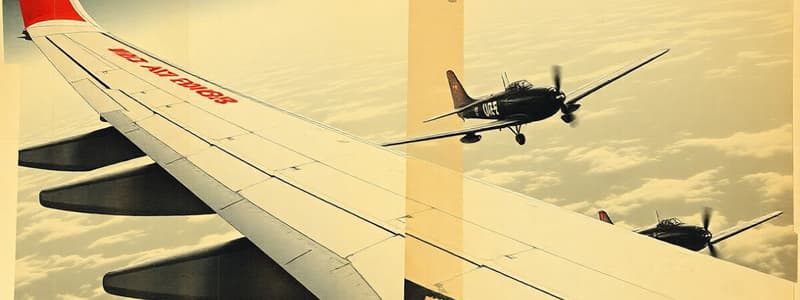Podcast
Questions and Answers
What is one purpose of wing flaps?
What is one purpose of wing flaps?
- To decrease wing area to vary the lift.
- To enable the pilot to make steeper approaches to a landing without increasing the airspeed. (correct)
- To relieve the pilot of maintaining continuous pressure on the controls.
One of the main functions of flaps during approach and landing is to
One of the main functions of flaps during approach and landing is to
- decrease the angle of descent without increasing the airspeed.
- permit a touchdown at a higher indicated airspeed.
- increase the angle of descent without increasing the airspeed. (correct)
What is the purpose of the rudder on an airplane?
What is the purpose of the rudder on an airplane?
- To control overbanking tendency.
- To control roll.
- To control yaw. (correct)
Which is not a primary flight control surface?
Which is not a primary flight control surface?
Which statement is true concerning primary flight controls?
Which statement is true concerning primary flight controls?
Which device is a secondary flight control?
Which device is a secondary flight control?
The four forces acting on an airplane in flight are
The four forces acting on an airplane in flight are
When are the four forces that act on an airplane in equilibrium?
When are the four forces that act on an airplane in equilibrium?
The term "angle of attack" is defined as the angle between the
The term "angle of attack" is defined as the angle between the
The angle of attack at which an airplane wing stalls will
The angle of attack at which an airplane wing stalls will
What force makes an airplane turn?
What force makes an airplane turn?
An airplane said to be inherently stable will
An airplane said to be inherently stable will
In the Northern Hemisphere, a magnetic compass will normally indicate a turn toward the north if
In the Northern Hemisphere, a magnetic compass will normally indicate a turn toward the north if
During flight, when are the indications of a magnetic compass accurate?
During flight, when are the indications of a magnetic compass accurate?
Which instrument will become inoperative if the pitot tube becomes clogged?
Which instrument will become inoperative if the pitot tube becomes clogged?
Which instrument(s) will become inoperative if the static vents become clogged?
Which instrument(s) will become inoperative if the static vents become clogged?
What does the red line on an airspeed indicator represent?
What does the red line on an airspeed indicator represent?
What is density altitude?
What is density altitude?
What is pressure altitude?
What is pressure altitude?
Under what condition is pressure altitude and density altitude the same value?
Under what condition is pressure altitude and density altitude the same value?
What action can a pilot take to aid in cooling an engine that is overheating during a climb?
What action can a pilot take to aid in cooling an engine that is overheating during a climb?
If the grade of fuel used in an aircraft engine is lower than specified for the engine, it will most likely cause
If the grade of fuel used in an aircraft engine is lower than specified for the engine, it will most likely cause
What type fuel can be substituted for an aircraft if the recommended octane is not available?
What type fuel can be substituted for an aircraft if the recommended octane is not available?
Filling the fuel tanks after the last flight of the day is considered a good operating procedure because this will
Filling the fuel tanks after the last flight of the day is considered a good operating procedure because this will
Flashcards
Wing Flaps: What's their purpose?
Wing Flaps: What's their purpose?
A primary flight control surface that increases wing camber and angle of attack, increasing lift and induced drag, enabling steeper landings without increasing airspeed.
Rudder: What does it control?
Rudder: What does it control?
The rudder is the primary control surface that controls movement around the vertical axis of the aircraft, known as yaw. Yaw is the motion of an airplane's nose left or right.
Primary Flight Controls: Which are they?
Primary Flight Controls: Which are they?
The primary flight controls are the ailerons, elevator (or stabilator), and rudder. Flaps are considered secondary flight control surfaces.
Primary Flight Control Effectiveness: What influences it?
Primary Flight Control Effectiveness: What influences it?
Signup and view all the flashcards
Forces in Flight: What are the four main ones?
Forces in Flight: What are the four main ones?
Signup and view all the flashcards
Equilibrium in Flight: When does it occur?
Equilibrium in Flight: When does it occur?
Signup and view all the flashcards
Angle of Attack: How is it defined?
Angle of Attack: How is it defined?
Signup and view all the flashcards
Stall Angle of Attack: When does it occur?
Stall Angle of Attack: When does it occur?
Signup and view all the flashcards
Force in Turns: What causes an airplane to turn?
Force in Turns: What causes an airplane to turn?
Signup and view all the flashcards
Inherent Stability: What does it mean?
Inherent Stability: What does it mean?
Signup and view all the flashcards
Compass Turning Error: When does it occur?
Compass Turning Error: When does it occur?
Signup and view all the flashcards
Compass Accuracy: When is it reliable?
Compass Accuracy: When is it reliable?
Signup and view all the flashcards
Pitot Tube: What instrument relies on it?
Pitot Tube: What instrument relies on it?
Signup and view all the flashcards
Static Vents: What instruments rely on them?
Static Vents: What instruments rely on them?
Signup and view all the flashcards
Red Line on Airspeed Indicator: What does it signify?
Red Line on Airspeed Indicator: What does it signify?
Signup and view all the flashcards
Density Altitude: How is it defined?
Density Altitude: How is it defined?
Signup and view all the flashcards
Pressure Altitude: What is it?
Pressure Altitude: What is it?
Signup and view all the flashcards
Pressure Altitude vs. Density Altitude: When are they equal?
Pressure Altitude vs. Density Altitude: When are they equal?
Signup and view all the flashcards
Cooling an Overheating Engine: What action can a pilot take?
Cooling an Overheating Engine: What action can a pilot take?
Signup and view all the flashcards
Low-Grade Fuel: What can it lead to?
Low-Grade Fuel: What can it lead to?
Signup and view all the flashcards
Fuel Substitution: What's the proper procedure?
Fuel Substitution: What's the proper procedure?
Signup and view all the flashcards
Fuel Tank Filling: Why is it important?
Fuel Tank Filling: Why is it important?
Signup and view all the flashcards
Ailerons: What do they control?
Ailerons: What do they control?
Signup and view all the flashcards
Spoilers: What are they and what's their purpose?
Spoilers: What are they and what's their purpose?
Signup and view all the flashcards
Elevator/Stabilator: What does it control?
Elevator/Stabilator: What does it control?
Signup and view all the flashcards
Trim Systems: What are they and what's their purpose?
Trim Systems: What are they and what's their purpose?
Signup and view all the flashcards
Overbanking Tendency: What is it?
Overbanking Tendency: What is it?
Signup and view all the flashcards
Weight: What is it and how does it affect flight?
Weight: What is it and how does it affect flight?
Signup and view all the flashcards
Thrust: What is it and how does it affect flight?
Thrust: What is it and how does it affect flight?
Signup and view all the flashcards
Drag: What is it and how does it affect flight?
Drag: What is it and how does it affect flight?
Signup and view all the flashcards
Study Notes
Wing Flaps
- One purpose of wing flaps is to enable pilots to make steeper approaches to landings without increasing airspeed.
- Flaps increase wing camber and the angle of attack, which increases lift and induced drag, allowing for steeper approaches.
- Trim tabs, not wing flaps, help relieve control pressures.
- Wing area usually remains the same, except for some specialized flaps that increase wing area.
Flaps During Approach and Landing
- One main function of flaps during approach and landing is to increase the angle of descent without increasing airspeed.
- Extending flaps increases lift and induced drag enabling descent without increasing airspeed.
- Flaps increase lift at slow airspeeds, allowing for touchdown at a lower indicated airspeed.
Rudder Purpose
- The rudder controls yaw, which is rotation about the airplane's vertical axis.
- Ailerons, not the rudder, control overbanking tendency.
- Overbanking tendency occurs when the outside wing travels significantly faster than the inside wing in a steep turn.
Primary Flight Control Surfaces
- The three primary flight controls are ailerons, elevator (or stabilator), and rudder.
- Flaps are not primary flight controls but secondary flight controls, as are spoilers.
- Stabilator or elevator is a primary control surface.
- Ailerons are a primary control surface, controlling roll.
Aerodynamic Forces
- The four forces acting on an airplane in flight are lift, weight, thrust, and drag.
- Lift is produced by the wings and opposes weight (the result of gravity).
- Thrust is produced by the engine/propeller and opposes drag (resistance of air).
- The four forces are in equilibrium during unaccelerated level flight.
Angle of Attack
- Angle of attack is the angle between the wing's chord line and the relative wind.
- The wing chord line is a straight line from the leading to the trailing edge of the wing.
- The relative wind is the airflow relative to the wing.
Angle of Attack and Stalls
- The angle of attack at which an airplane wing stalls remains the same regardless of gross weight, airspeed, load factor, or density altitude.
- The critical angle of attack causes airflow to separate from the upper wing surface, resulting in a stall.
Airplane Turn
- The horizontal component of lift is the force that makes an airplane turn.
- The vertical component of lift acts to oppose weight and control vertical movement.
- Centrifugal force acts toward the outside of the turn.
Inherently Stable Airplane
- An airplane said to be inherently stable requires less effort to control.
- It will return to its original condition of flight (except in a bank) after a disturbance like turbulence.
- Stability does not affect the difficulty of entering a stall.
Magnetic Compass
- A magnetic compass in the Northern Hemisphere will indicate a turn toward north during acceleration, particularly while on an east or west heading.
- Turn toward north during acceleration as opposed to deceleration.
- Accurate Compass Indications: Straight and level, unaccelerated flight.
Pitot-Static System and Instruments
- The pitot tube is part of the pitot-static system providing ram air pressure for airspeed indicators.
- Clogged pitot tubes (or static vents) will cause airspeed indicators, altimeters, and vertical speed indicators to become inoperative.
- The altimeter operates on the static system, not pitot.
Airspeed Indicator
- The red line on an airspeed indicator represents the maximum speed at which an airplane should be flown (the never-exceed speed).
Density Altitude
- Density altitude is the pressure altitude corrected for non-standard temperature.
- Pressure altitude is an aircraft's height above the standard datum plane, corrected to 29.92" Hg.
Engine Overheating
- A pilot can reduce climb speed and increase airspeed to aid in cooling an overheating engine.
- Reducing airspeed will hinder cooling. Increasing RPM will further increase engine temperature.
Fuel Grade
- Using a lower grade of fuel in an aircraft engine usually leads to detonation.
- Lower grades of fuel ignite at lower temperatures and are less likely to explode.
- Use of the next higher octane if the recommended one is not available as a replacement fuel.
Studying That Suits You
Use AI to generate personalized quizzes and flashcards to suit your learning preferences.




